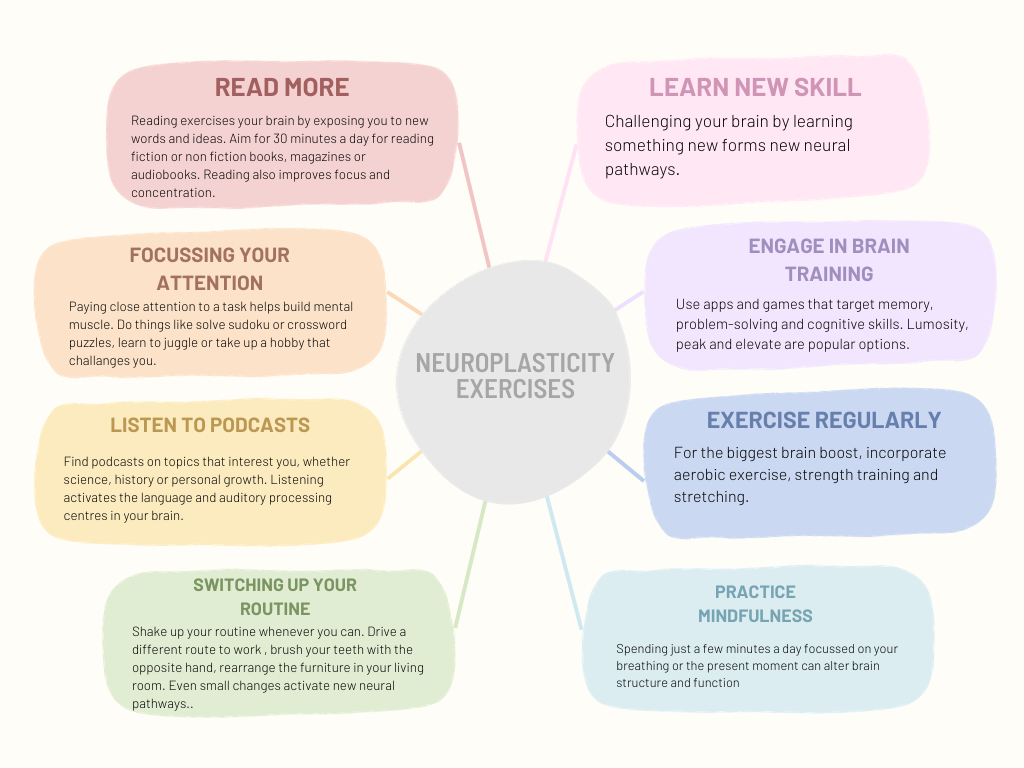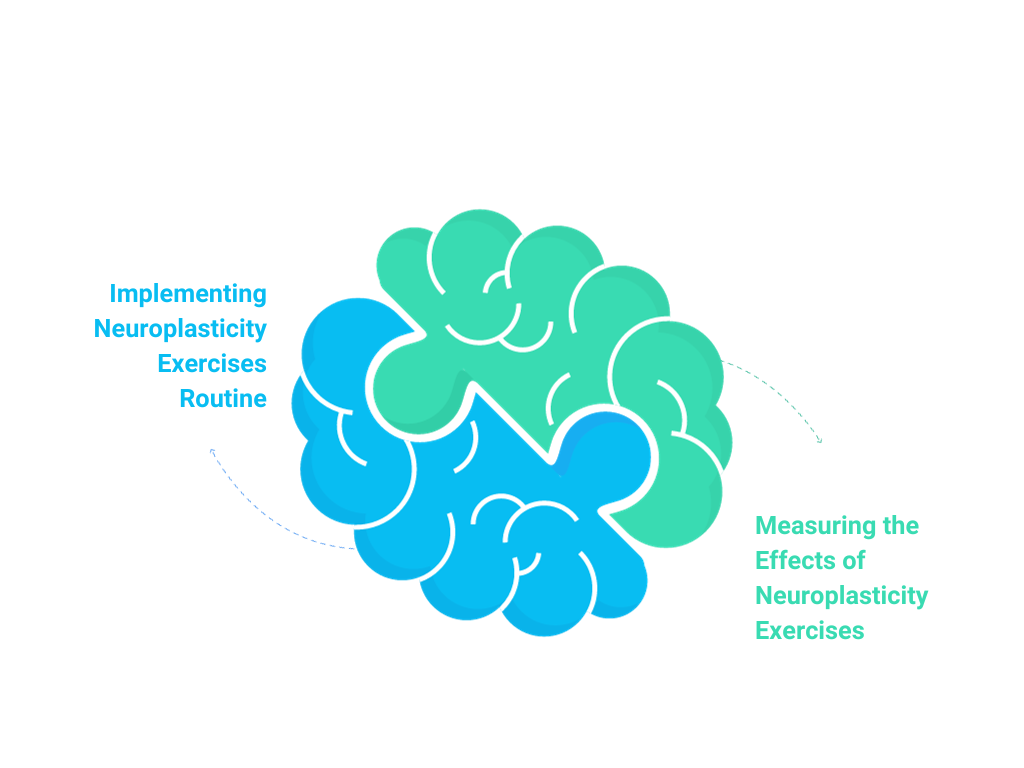In this article , we’ll explore 10 easy neuroplasticity exercises you can incorporate into your daily routine to strengthen your brain. Doing regular brain exercises has been shown to improve memory, cognitive abilities, mental well being and more. While you may not become a genius overnight , with time and practice you can build new neural pathways in your brain to make yourself smarter, happier and healthier. So put on your workout gear for your brain and lets get started. These neuroplasticity exercises are simple to do but can have life-changing effects.
Table of Contents
What is Neuroplasticity?
Neuroplasticity refers to the brain’s ability to recognise itself by forming new neural connections throughout life. Your brain is constantly changing and reshaping itself based on your experiences, environment and behaviours. The good news is you can harness the power of neuroplasticity to strengthen neural pathways in your brain through targeted exercises.
1- Learn a new skill. Pick a hobby, instrument, language or sport. Challenging your brain by learning something new forms new neural pathways. The more you practice, the stronger those connections become.
2- Engage in brain training. Use apps and games that target memory, problem-solving and cognitive skills. Lumosity, peak and elevate are popular options. While research is mixed , brain training may boost connectivity and help maintain brain health.
3- Exercise regularly. Exercise increases blood flow to your brain, prompting the growth of new neural connections. Even taking a 30 minutes walk a few times a week can help. For the biggest brain boost, incorporate aerobic exercise, strength training and stretching.
4- Practice mindfulness. Spending just a few minutes a day focussed on your breathing or the present moment can alter brain structure and function. Mindfulness meditation leads to changes including increased connectivity and reduced activity in the default mode network, the part of your brain responsible for mind-wandering.
5- Get adequate sleep. Sleep is essential for memory consolidation, cognitive performance and neuroplasticity. aim for 7 to 9 hours of sleep per night to give your brain the rest it needs to strengthen new neural connections formed during the day.
6- Socialise regularly. Social interaction and engagement have a profound effect on brain health and connectivity. Connecting with others lead to the release of hormones and neurotransmitters that promote neural plasticity. Make spending time with people you enjoy a priority.
The Science Behind Neuroplasticity Exercises
When it comes to neuroplasticity exercises, its all about rewiring your brain by forming new neural pathways. The more you repeat an activity, the stronger those connections become.
Focusing your attention
Paying close attention to a task helps build mental muscle. Do things like solve sudoku or crossword puzzles, learn to juggle or take up a hobby that challanges you. Start with just 10-15 minutes a day of focused concentration and work your way up.
Practicing Mindfulness
Spending a few days every day being fully present in the moment can work wonders. Try meditating, deep breathing, yoga or tai chi. The goal is to clear your mind and focus your awareness on your breath and body. With regular practice, these techniques get easier and benefits increase.
Switching up your routine
Doing the same thing in and day out gets boring for your brain. Shake up your routine whenever you can. Drive a different route to work , brush your teeth with the opposite hand, rearrange the furniture in your living room. Even small changes activate new neural pathways.
Learning a new skill
Pick up a hobby or activity that pushes you outside your comfort zone like learning to code, play an instrument, speak a foreign language or cook ethnic cuisine. Aquiring new talents exercises your brain in love; ways. Start with the basics and build from there.
when you make neuroplasticity exercises a habit , you will boost your brain health, cognitive abilities and daily functioning. Why not give your most powerful organ a mental workout? Your mind will thank you.
Top 5 Neuroplasticity Exercises to Rewire Your Brain
Practice Mindfulness
Slowing down your thoughts through mindfulness exercise is one of the best ways to rewire your brain. spending just a few minutes a day being fully present can help strengthen neural connections in your brain.
Try simple mindfulness techniques like:
- Deep Breathing: Take slow, deep breaths from your diaphragm to clear your mind and focus your awareness on your breathing. Start with judt 5-10 minutes a day.
- Body Scan: Systematically tense and relax different muscle group in your body one by one. Focus your attention on the sensations in each part of your body. Release any tension and just notice how your body feel.
- Sensory Awareness: Focus on your senses, one at a time. Notice what you see, hear, smell, feel and taste. Appreciate the simple details in your surroundings.
Learn a new skill
Challenging your brain by learning a new skill or hobby is one of the best ways to build neural connections. Take up a musical instrument, learn to code, start a garden, learn a new language or take an online course on a topic that interests you. The key is to stick with it long enough to improve and strengthen those new neural pathways.
Limit distractions
Minimise interruptions and focus your attention. Put away your phone and other electronics. Find a place free of noise and visual diversions. Give your full focus to one task at a time. Single-tasking helps strengthen self-control and the ability to concentrate, both of which rely on neuroplasticity.
Implementing Neuroplasticity Exercises Routine
Implementing a regular neuroplasticity exercises routine is key to rewire your brain. Start with just 10-15 minutes a day targeted exercises and build up from there. Even small changes can have big impacts over time.
Learn a new skill
Pick up a hobby or try learning a new language. Learning activates new neural pathways in your brain. As you practice those connections strengthen, enhancing your mental flexibility and memory.
Read More
Reading exercises your brain by exposing you to new words and ideas. Aim for 30 minutes a day for reading fiction or non fiction books, magazines or audiobooks. Reading also improves focus and concentration.
Do brain training apps
Use brain training apps like Lumosity, Elevate or Peak that offer short games targetting memory, problem-solving and cognitive skills. Studies show people who regularly use these apps experience improved brain connectivity and performance.
Listen to podcasts
Podcasts provide an easy way to keep learning on the go. Find podcasts on topics that interest you, whether science, history or personal growth. Listening activates the language and auditory processing centres in your brain.
Travel
Travelling exposes you to new environments and experience that build neural pathways in your brain. Even short trips can stimulate your senses and enhance creativity. Travelling has also been shown to boost happiness and well-being.
Socialize
Social interaction and relationships are vital for brain health and neuroplasticity. Call a friend, join an online community or volunteer. Socialising releases dopamine that fuels learning and motivation. Strong social ties also help reduce stress and depression.
Implementing these neuroplasticity exercises , even in small ways, will strengthen the connections in your brain over time. Be patient and consistent , and you will start to notice improved memory, mental focus, learning and well-being. Your mind and brain will be grateful.

Measuring the Effects of Neuroplasticity Exercises
Once you started doing regular neuroplasticity exercises, how can you tell if they are actually helping to rewire your brain? Here are a few ways to measure the effects:
Improved Memory
If the exercises are enhancing your brain’s connectivity and neural pathways, you should notice improvements in your memory, especially short-term recall. Try memorising a list of random words or a phone number. Is it getting easier?
Improved focus
Neuroplasticity exercises that target attention and concentration areas of the brain can boost your focus and concentration. See if you can work on a mentally demanding task for a longer without distraction or if you notice more details in your environment.
Better problem-solving
Exercise that stimulate the prefrontal cortex, responsible for cognitive control and flexibility can enhance your problem-solving skills. Do you find yourself navigating challenges at work or home with more creativity and efficiency? Are you open to trying new solutions?
Reduced stress and anxiety
Many neuroplasticity exercises work to balance activity in the left and right hemispheres of the brain with can help ease symptoms of stress, depression and anxiety. Notice if you feel calmer in stressful situations or if your mood seems more stable and positive in general.
Improved sleep
If the exercises are activating and energising your brain during the day, it should lead to better sleep at night. A rewired, optimised brain will transition more easily into sleep. Are you falling into sleep faster, sleeping more soundly and waking up feeling more refreshed?
Keep a journal and record your observations to see the overall effects of your neuroplasticity exercises over time. While change may happen gradually, you should notice significant and lasting improvements in your brain function, cognition and well-being. Stay dedicated to the exercises and continue challenging your brain- neuroplasticity is an ongoing process.
Things to keep in mind
So there you have it, 10 simple but powerful ways to rewire your brain and strengthen your neural connections. Don’t underestimate the impact these exercises can have on your mind and life. The more you practice them, the more profound and lasting the changes will be. Your brain’s capacity for change is truly limitless. You have the power to reshape your mind and build mental muscles that will serve you as well for years to come. Stay dedicated and consistent with these techniques and you will be amazed at what you can achieve. Keep learning, growing and pushing the boundaries of your mind.

FAQs: 10 Life-Changing Astounding Neuroplasticity Exercises
1. What are Neuroplasticity Exercises?
- Neuroplasticity exercises are mental activities or practices designed to harness the brain’s ability to reorganize itself by forming new neural connections and pathways. These exercises aim to promote brain health, cognitive function, and emotional well-being by stimulating neuroplasticity.
2. How do Neuroplasticity Exercises benefit the brain?
- Neuroplasticity exercises can benefit the brain in various ways, including enhancing cognitive function, improving memory and learning abilities, boosting mood and emotional resilience, and supporting recovery from brain injuries or neurological conditions. By engaging in targeted mental activities, individuals can strengthen neural networks and promote overall brain health.
3. What are some examples of Neuroplasticity Exercises?
- Examples of Neuroplasticity Exercises include practicing mindfulness meditation, engaging in brain training games and puzzles, learning new skills or languages, practicing visualization and mental imagery, engaging in physical exercise, journaling or expressive writing, engaging in creative activities such as drawing or painting, socializing and connecting with others, challenging cognitive tasks such as memorization or problem-solving, and exposing oneself to novel experiences and environments.
4. How often should I practice Neuroplasticity Exercises?
- The frequency and duration of Neuroplasticity Exercises may vary depending on individual preferences, goals, and schedules. Some experts recommend incorporating these exercises into daily routines, while others suggest practicing them several times per week. Consistency and regularity are key to maximizing the benefits of Neuroplasticity Exercises.
5. Can Neuroplasticity Exercises help improve memory and cognitive function?
- Yes, Neuroplasticity Exercises are known to enhance memory and cognitive function by strengthening neural connections associated with learning and memory processes. Activities such as brain training games, mental imagery, and learning new skills can help improve memory recall, attention, and overall cognitive performance.
6. Are Neuroplasticity Exercises suitable for individuals of all ages?
- Yes, Neuroplasticity Exercises can be beneficial for individuals of all ages, from children to older adults. The brain’s ability to rewire and adapt through neuroplasticity persists throughout life, allowing individuals to continue learning, growing, and improving cognitive function regardless of age.
7. Can Neuroplasticity Exercises help with mental health and emotional well-being?
- Yes, Neuroplasticity Exercises have been shown to have positive effects on mental health and emotional well-being by promoting stress reduction, emotional regulation, and resilience. Practices such as mindfulness meditation, expressive writing, and socializing can help cultivate a positive mindset and improve overall emotional health.
8. How long does it take to see results from Neuroplasticity Exercises?
- The timeline for seeing results from Neuroplasticity Exercises may vary depending on individual factors such as baseline cognitive function, consistency of practice, and the specific exercises being performed. While some individuals may experience immediate benefits, others may require several weeks or months of regular practice to notice significant improvements.
9. Can Neuroplasticity Exercises help with recovery from brain injuries or neurological conditions?
- Yes, Neuroplasticity Exercises can play a valuable role in supporting recovery from brain injuries or neurological conditions by promoting neuroplasticity and neural repair. Rehabilitation programs often incorporate targeted exercises to help individuals regain lost functions, improve cognitive abilities, and adapt to changes in brain structure and function.
10. Are there any risks or side effects associated with Neuroplasticity Exercises?
- Neuroplasticity Exercises are generally safe and well-tolerated for most individuals. However, it’s essential to listen to your body and practice moderation, especially when engaging in challenging cognitive tasks or physical activities. If you experience discomfort or adverse effects while practicing Neuroplasticity Exercises, consult with a healthcare professional for personalized guidance and support.
Conclusion:
In conclusion, neuroplasticity gives you the power to reshape your brain. By performing targeted exercises, you can strengthen neural connections in the areas of the brain that control focus, emotional regulation , learning and more.
To keep your brain flexible and sharp, make a habit of regularly practice exercises like:
- Minfulness Meditation. Spending just a few minutes a day focused on your breath can have significant benefits for both the structure and function of your brain.
- Learn a new skill. Pick up a hobby like playing an instrument , learning a new language or juggling. New skill create new neural pathways.
- Exercise your body. Go for a walk or jog , do some yoga or strength train. Physical activity supplies oxygen to your brain and promotes the growth of new neural connections.
- Read books. Curl up with an engaging book, fiction or nonfiction. Reading exercises your brain and has been shown to increase connectivity in the areas involved with language and visual/spatial processing.
- Travel. Experience new places and cultures. Travelling challenges your brain by exposing it to new environments and ways of thinking.
- Practice memorisation. Memorise poetry, lists of vocabulary words or names of people you meet. Using mnemonics and memory tricks makes creating and strengthening neural connections fun.
Your brain’s ability to rewire itself is truly extraordinary. Make the most of your brain’s plasticity and take up exercises that will enhance your mental abilities for years to come. With regular practice of neuroplasticity exercises, you’ll be on your way to a healthier, happier and sharper mind.




